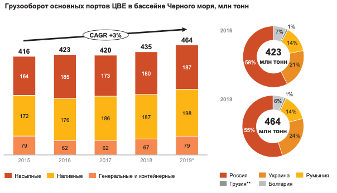PwC Russia presents the second edition of the report Sea Port Development on the Cross-Roads of International Routes that contains analysis of the main events, promising infrastructure projects, main trends and developments of the port industry in Central and Eastern Europe (CEE) region.
The Roscongress Foundation presents the salient points of the publication accompanied by fragments of broadcasts of relevant panel discussions from the business programme of international events held by the Roscongress Foundation.
Impact of COVID-19 is still not clear enough, but the crisis caused by coronavirus pandemic shall give an impetus to increase port efficiency.
Basically, global protracted crisis in any industry contributes to faster eradication of inefficient approaches, on the one hand, and development of advanced technologies and trends, on the other hand. Therefore, in order to understand impact of COVID-19 on the port industry, development trends shall be considered in the first place. Long-term protects are most likely to advance and become reality not tomorrow, but already today.
Thus, PwC experts have distinguished key trends of the port industry that may primarily contribute to changes in the market influenced by COVID-19:
1. Development of international corridors, diversification of supply chains and the resulting investments in CEE ports.
2. Vertical integration of various logistics and supply chain players, incorporation of hybrid companies with carriers and port terminals and investing in with hinterland infrastructure and inland ports.
3. Stricter sustainable development requirements for ports, including deeper coordination among port sector players, and the growing role of digitalization in ports.
The Black Sea ports upscale export and develop transit between Asia and Europe. Main trends in the Black Sea basin are related to increase in export of Russian and Ukrainian goods and emerging of new transit opportunities.
The authors note an increase in export of Russian and Ukrainian goods that triggered developments of Taman and Novorossiysk ports along with extension of trade routes and jumboizing. Load of new facilities can me mainly ensured by oil, oil products and grains.
The Black Sea is a key component of the South corridor in terms of project One Belt One Way. Therefore, Chinese investors started to seek new assets at the Black Sea for business expansion. In 2019, China Machinery Engineering Corporation has concluded a contract for development of Bulgarian port Varna.

Digitization is one of the most prominent changes in the transportation and logistics industry. Introduction of digital technologies shall contribute to seamless and efficient framework of the supply chain for the consignors benefit. The main goal of digitization is integration of ports into the global network of Smart Ports.
Unified digital platform is a strategic priority for ports. The Smart Port concept has become a key technology trend in transformation and digitization of ports. One of the priorities in development of the port operating model is bringing all players of the global supply chain into a single network on a digital platform that enables instant data exchange and effective decision making.

The first digitization step is digitization of certain supply chain players and its integration into the unified Port Community System (PCS).
The next step is integration of various port systems into a single Smart Port Network that shall become a platform of the global logistics chain.
For more information about construction as a sector with a sizeable share in many economies, rising level of digitalization, and shifts in consumer sentiment in real estate, please see the Transport and logistics, Mobility, Shipbuilding, EU and Location economics.






